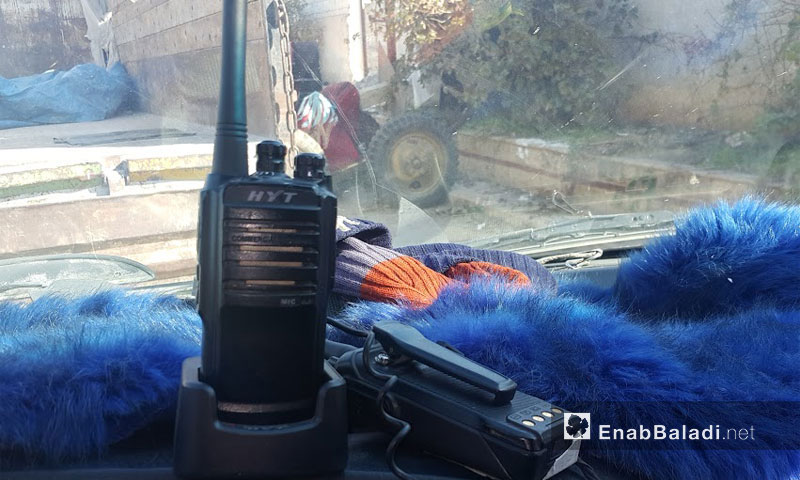Enab Baladi – Idlib
I was on the international highway south of Saraqib city heading to Aleppo’s western countryside when on the wireless device – my constant friend – an observer alerted me that a Russian warplane was headed southwards from northern Saraqib.
“The airplane has finished its mission in Aleppo and is returning to the Hmeimim airbase,” the voice on the wireless device said. The words filled listeners with relief but suddenly, the airplane launched two cluster bombs over the eastern part of the town as it reached Saraqib’s airspace.
The shouts of the observers rose from the wireless device, “Stay alert until it leaves the airspace… the pig released a bomb after he reported his return.” The comments were followed by advice for everyone, “People! Never trust a fighter, even if they report that they have completed their task… they are not trustworthy! Liars!”
The entire episode unfolded in under two minutes according to Baraa Doumani, a resident of Idlib city who works for an aid organization.
Russian Airplanes and Syrian Observers
In almost every liberated area, a resident volunteers to warn people about repeat air strikes, the location of airplanes and their takeoff. This person is referred to as the “observer”, according to Mohammad Saeed, an observer in Idlib’s southern countryside who refused to name the area he is responsible for, for security reasons.
Speaking of the nature of his work as an observer, Saeed clarified that most observers use various wireless devices, which can catch the wireless signals pilots use to communicate with airbases. Through the signals, the pilot informs the base of the start of his mission, its end and the location of his operation, if he has pre-determined targets or will bomb according to observation on site, and other information that may be useful to alert and warn people. The pilots and airbases use code and change the code repeatedly, and part of observers’ tasks is to break the code by observing the pilots and figuring out the path of their operation and the potential targets.
Saeed added that, in some cases, the airbase sends the pilot orders giving him a new target that was not there before he took off, such as a civilian gathering in a town or vehicles in another area. This part of the signals is not coded, as Saeed explained, “We warn the area that is being spoke about, perhaps we can protect some civilians from the brutality of the coming air strike.”
Regarding Syrian warplanes, the observer can identify the type of airplane and the airbase it took off from, for example, “MiG 23 warplane from Hama airport or warplane armed with artillery from al-Nirab airport.” It is possible to detect the plane’s path from its first strike as every plane has a specific area of operation.
Observers cannot identify the type of Russian airplane; they can only know if the airplane took off from Hmeimim airport and when it finishes its mission.
Alliance Airplanes Cannot be Observed
“Russian and Syrian airplanes are not the only ones flying in Syrian airspace. There are the international alliance airplanes, which we can never detect,” said Mohammad Saeed.
But there are ways to identify the alliance’s airplanes, according to Saeed. He explained that observers count the Russian and Syrian airplanes present, so if there is an unknown airplane in the air then it is an alliance airplane but there is no additional information about these airplanes.
This operation has become more complicated after Russian airplanes started taking off from the Admiral Kuznetsov aircraft carrier located in the Mediterranean Sea, which began their operations on 15 November.
Pilots know that observers infiltrate their communication channels, so they send false orders to mislead them. A pilot gives the signal that he will execute aerial strikes in southern Aleppo and suddenly targets an area in Idlib’s countryside or announces the end of his mission and bombs a particular area en route to the airbase.
The sky above the liberated areas of Syria is rarely free of airplanes as there is no shield to stop the warplanes, and northern residents have found no method other than this to give people a least a minimal warning. The idea began when people started using wireless devices to communicate after other forms of communication were cut off. The method evolved to become the main means of spreading warnings and news between people, informing them of decisions and services, and alerting them of theft or vaccination campaigns among other things.

